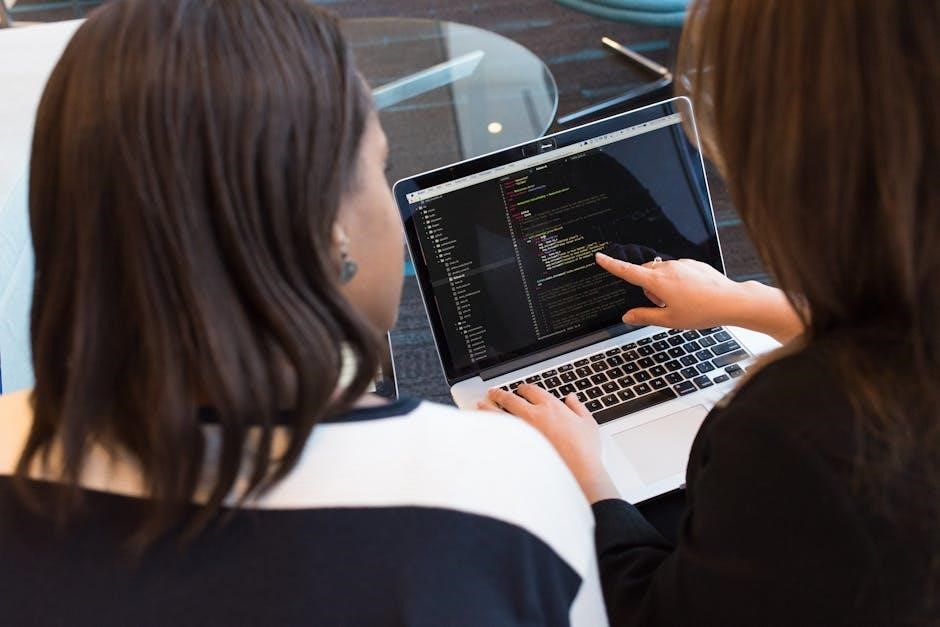CPT codes are essential for accurate billing of medical procedures, including CT-guided liver biopsies. These codes ensure proper reimbursement and documentation of services provided. CPT 47000 and 77012 are commonly used for liver biopsy and CT guidance, respectively. Understanding these codes is crucial for precise billing and compliance with medical coding standards.
Overview of CPT Codes and Their Importance in Medical Billing
CPT (Current Procedural Terminology) codes are standardized codes used to describe medical, surgical, and diagnostic procedures. They are essential for accurate billing and insurance reimbursement. These codes ensure uniformity in documenting services, facilitating communication between healthcare providers and payers. CPT codes like 47000 and 77012 are critical for procedures such as liver biopsies, distinguishing between percutaneous and surgical methods. Accurate coding ensures proper reimbursement and compliance with regulations. CPT codes also help reduce billing errors, streamline administrative processes, and provide transparency for patients and insurers. Their precise use is vital for maintaining efficient healthcare billing systems and ensuring fair compensation for medical services provided.
Brief Explanation of Liver Biopsy Procedures
A liver biopsy involves obtaining a small tissue sample from the liver to diagnose liver diseases, monitor conditions, or assess treatment effectiveness. The procedure is typically performed using a needle (percutaneous biopsy) or surgically (incisional biopsy). Percutaneous biopsies are less invasive and commonly guided by imaging techniques like CT or ultrasound to ensure accuracy. The patient lies still during the procedure, and local anesthesia is used to minimize discomfort. The liver tissue is then analyzed in a laboratory for abnormalities, such as inflammation, scarring, or cancer cells. Liver biopsies are crucial for confirming diagnoses and guiding patient care. Proper imaging guidance enhances precision and safety during the procedure.
Role of Imaging Guidance in Liver Biopsy
Imaging guidance plays a critical role in liver biopsy by enhancing accuracy and safety. Techniques like CT scans provide real-time visualization, helping guide the needle to the target area. This reduces the risk of complications, such as bleeding or injury to adjacent structures. CT guidance is particularly useful for patients with challenging anatomy or those requiring precise sampling. It ensures the biopsy is performed efficiently and effectively, improving diagnostic outcomes. The use of imaging guidance also supports accurate coding, as specific CPT codes are assigned for these services, ensuring proper billing and reimbursement for the procedure. This integration of technology and medical practice underscores the importance of imaging in modern biopsy techniques.

Primary CPT Codes for Liver Biopsy
Primary CPT codes for liver biopsy include 47000 for percutaneous procedures and 47001 for surgical biopsies. CT guidance is separately reported using 77012.
CPT Code 47000: Percutaneous Liver Biopsy
CPT code 47000 pertains to a percutaneous liver biopsy, where a needle or catheter is used to obtain liver tissue. This minimally invasive procedure is typically performed under imaging guidance, such as CT or ultrasound, to ensure accuracy. The code does not include imaging guidance, which must be reported separately using CPT 77012 for CT-guided procedures. Percutaneous liver biopsies are commonly used to diagnose liver conditions, such as cirrhosis or malignancies. It is important to note that this code applies only to non-surgical, image-guided biopsies, distinguishing it from surgical biopsy codes like 47001. Accurate coding ensures proper reimbursement and documentation of the procedure.
CPT Code 47001: Surgical Liver Biopsy (Incisional)
CPT code 47001 is assigned to surgical liver biopsies performed via an incision, typically during an open procedure. This code applies when a liver biopsy is obtained through a surgical incision, distinguishing it from percutaneous methods. Imaging guidance, such as CT, is not included in this code and must be reported separately if used. Surgical biopsies are often performed in cases where percutaneous biopsy is not feasible or when additional surgical interventions are required. Accurate documentation of the procedure is essential to ensure correct billing and compliance with coding guidelines. This code is distinct from 47000, which pertains to percutaneous biopsies, and is used for open or surgical cases only.
CPT Code 77012: Computed Tomography Guidance for Biopsy
CPT code 77012 is used to report computed tomography (CT) guidance for biopsy procedures. This code specifically applies when CT imaging is utilized to direct the needle placement during a biopsy, ensuring precise targeting of the tissue sample. It is a separate, add-on code that is reported in addition to the primary biopsy procedure code, such as 47000 or 47001. The use of CT guidance enhances the accuracy of the biopsy and is commonly employed in cases where anatomical complexity or lesion location requires advanced imaging. Proper reporting of this code ensures accurate billing for the imaging guidance provided during the procedure.

Imaging Guidance in CT-Guided Liver Biopsy
CT imaging provides real-time guidance for precise needle placement during liver biopsy, enhancing accuracy and minimizing complications. It is a separate procedure requiring specialized expertise.
Importance of CT Guidance in Liver Biopsy Procedures
Importance of CT Guidance in Liver Biopsy Procedures
CT guidance significantly enhances the accuracy and safety of liver biopsy procedures. It allows for real-time imaging, ensuring precise needle placement and minimizing complications. By providing clear visualization, CT guidance helps target specific tissue samples effectively, reducing the risk of bleeding or damage to surrounding structures. This method is particularly beneficial for patients with complex anatomy or lesions in challenging locations. The use of CT guidance improves diagnostic yield and patient outcomes, making it a critical component of modern liver biopsy practices. Its role in ensuring procedural safety and efficacy cannot be overstated.
How CT Guidance Impacts Coding and Billing
CT guidance in liver biopsy procedures requires specific coding to ensure accurate billing and reimbursement. The use of CT imaging adds an additional layer of complexity, as it necessitates the use of dedicated CPT codes for imaging guidance. CPT code 77012 is specifically used to report the CT guidance portion of the procedure, while the biopsy itself is reported with CPT code 47000. This separation of codes ensures that both the procedure and the imaging guidance are properly documented and reimbursed. Failure to report the imaging guidance separately can lead to underpayment, as the imaging component is not included in the biopsy code itself. Accurate coding is essential to reflect the full scope of services provided and to comply with billing guidelines.
Separately Reportable Imaging Guidance Codes

Imaging guidance codes, such as CPT 77012 for CT guidance, are separately reportable from the liver biopsy procedure code (e.g., 47000). This is because imaging guidance is not included in the primary procedure code and must be billed independently. Failure to report these codes separately can result in underpayment, as the imaging component is essential for accurate procedure performance. For example, CPT 77012 specifically describes computed tomography guidance for needle placement during biopsy. Other imaging modalities, such as ultrasound (CPT 76942) or fluoroscopy (CPT 77002), also have distinct codes. Accurate reporting of these codes ensures proper reimbursement and compliance with coding guidelines.
Coding Guidelines for CT-Guided Liver Biopsy
Always follow official coding guidelines to ensure accurate reporting of CT-guided liver biopsy procedures. Select codes that reflect the procedure’s specifics, such as imaging guidance and biopsy type, and ensure documentation supports the codes chosen for compliance and proper reimbursement.
When to Use CPT Code 77012 for CT Guidance
When to Use CPT Code 77012 for CT Guidance
CPT code 77012 is used when CT guidance is utilized during a biopsy procedure. It applies to imaging guidance for needle placement, ensuring accurate targeting of the liver tissue. This code is reported separately from the primary biopsy procedure code (e.g., 47000) and is required when CT imaging directs the intervention. Use 77012 for percutaneous approaches where real-time CT imaging is essential for procedural success. It is not included in the biopsy code itself, so it must be billed separately to reflect the imaging component accurately. Always verify documentation to confirm CT guidance was performed and medically necessary for the procedure.
Correct Coding for Percutaneous vs. Surgical Biopsy
Correct Coding for Percutaneous vs. Surgical Biopsy
Correct coding for liver biopsy involves distinguishing between percutaneous and surgical approaches. CPT code 47000 is used for percutaneous liver biopsy, which is a needle-based procedure performed through the skin. In contrast, CPT code 47001 applies to surgical (incisional) liver biopsy, requiring an open or laparoscopic approach. Accurate coding depends on the method documented in the medical record. Percutaneous biopsies are less invasive and typically coded with 47000, while surgical biopsies involve more extensive procedures and are coded with 47001. Both codes may be paired with 77012 for CT guidance if imaging is used. Ensure the procedure type matches the CPT code for proper reimbursement and compliance.
Tips for Avoiding Coding Errors in Liver Biopsy Procedures
To avoid coding errors in liver biopsy procedures, ensure accurate documentation of the procedure type (percutaneous or surgical) and whether imaging guidance was used. Verify that CPT codes 47000 (percutaneous) or 47001 (surgical) are correctly assigned based on the method performed. Always append CPT code 77012 for CT guidance when applicable, as it is separately reportable. Double-check patient records to confirm the procedure details and imaging use. Stay updated on CPT coding guidelines and revisions to avoid outdated or incorrect codes. Proper training and regular audits can also help minimize errors and ensure compliance with billing standards. Accurate coding ensures proper reimbursement and reduces the risk of denied claims.

Reimbursement and Insurance Considerations
Reimbursement for CT-guided liver biopsy varies by payer and policy. Insurance coverage depends on medical necessity and procedure coding accuracy. Verify patient eligibility and coding compliance to ensure proper payment.
Reimbursement Rates for CPT Code 47000
Reimbursement Rates for CPT Code 47000
Reimbursement rates for CPT code 47000, which pertains to percutaneous liver biopsy, vary depending on payer policies, patient demographics, and healthcare settings. Medicare and private insurers typically cover this procedure when deemed medically necessary. Payment rates are influenced by factors such as geographic location, facility type, and the specific terms of the patient’s insurance plan. For example, Medicare reimbursement for CPT 47000 is approximately $250-$350, while private payers may offer higher or lower rates based on contractual agreements. Accurate coding and documentation are critical to ensure proper payment. Always verify reimbursement details with the payer to avoid billing discrepancies.
Insurance Coverage for CT-Guided Liver Biopsy
Insurance Coverage for CT-Guided Liver Biopsy
Insurance coverage for CT-guided liver biopsy varies by payer and policy; Most major insurers, including Medicare and private plans, cover the procedure when deemed medically necessary. Pre-authorization may be required to ensure reimbursement. CPT codes 47000 (for the biopsy) and 77012 (for CT guidance) are typically included in coverage. Patients should verify their plan details to understand copays, deductibles, or coinsurance. Coverage depends on the clinical indication, such as diagnosing liver disease or monitoring cancer. Accurate coding and documentation are essential to avoid claim denials. Always check with the insurer for specific coverage criteria and requirements.
Factors Influencing Reimbursement for Liver Biopsy
Factors Influencing Reimbursement for Liver Biopsy
Reimbursement for liver biopsy procedures depends on several factors, including medical necessity, accurate coding, and payer policies. Proper documentation of the patient’s condition and the procedure’s rationale is crucial. CPT codes 47000 (percutaneous biopsy) and 77012 (CT guidance) must be correctly assigned. Insurance coverage varies, with Medicare and private payers often requiring pre-authorization. The patient’s specific diagnosis and the procedure’s setting (inpatient vs. outpatient) also impact reimbursement rates. Coding errors or missing documentation can lead to denied claims. Additionally, regional payment policies and updates to coding guidelines can influence reimbursement amounts. Staying informed about coding changes ensures accurate billing and optimal reimbursement.

Clinical Applications of CT-Guided Liver Biopsy
CT-guided liver biopsy is essential for diagnosing liver diseases, assessing damage, and monitoring chronic conditions. It ensures precise tissue sampling, especially in challenging cases.
Indications for Liver Biopsy

Indications for Liver Biopsy
Liver biopsies are primarily indicated for diagnosing and staging chronic liver diseases. Key reasons include unexplained liver enzyme elevation, suspected cirrhosis, and monitoring chronic conditions like hepatitis. The procedure is also essential for evaluating liver damage in transplant patients and assessing tumor malignancy. CT guidance enhances precision, especially in challenging cases, ensuring accurate tissue sampling and reducing complications. It’s a critical diagnostic tool for hepatologists and radiologists to make informed treatment decisions. Accurate coding for these procedures is vital for proper billing and compliance with medical standards. Understanding the indications ensures appropriate use of CPT codes 47000 and 77012.
Diagnostic Value of CT-Guided Liver Biopsy
Diagnostic Value of CT-Guided Liver Biopsy
CT-guided liver biopsy offers high diagnostic accuracy, enabling precise tissue sampling under real-time imaging. This method reduces complications by avoiding vital structures and improves targeting of lesions. The use of CT ensures clear visualization, enhancing the reliability of biopsy results. It is particularly valuable for patients with complex anatomy or deep-seated lesions. The diagnostic value lies in its ability to provide tissue samples for histopathological examination, aiding in the confirmation of malignancy, staging of liver disease, and monitoring treatment response. Accurate coding, such as CPT 47000 for the biopsy and 77012 for CT guidance, ensures proper billing for this essential procedure.
Comparison with Other Imaging-Guided Biopsy Techniques
Comparison with Other Imaging-Guided Biopsy Techniques
CT-guided liver biopsy is often compared to ultrasound (US)-guided and MRI-guided biopsies. While US-guided biopsies are faster and avoid radiation, they may struggle with deep or complex lesions. MRI-guided biopsies offer superior soft-tissue contrast but are less accessible due to higher costs and limited availability. CT guidance provides excellent spatial resolution and is particularly useful for challenging anatomy or small lesions. It balances accuracy and accessibility, making it a preferred choice in many clinical settings. The choice of imaging guidance impacts both procedural success and patient outcomes, with CT offering a reliable middle ground between US and MRI.
Common Billing Scenarios and Examples
Common billing scenarios include reporting CPT 47000 for percutaneous biopsies and 77012 for CT guidance. Additional codes may apply for complications or combined procedures, ensuring accurate reimbursement.
Example 1: Percutaneous Liver Biopsy with CT Guidance
Example 1: Percutaneous Liver Biopsy with CT Guidance
A patient undergoes a percutaneous liver biopsy with CT guidance. The primary procedure involves CPT code 47000 for the biopsy and 77012 for the CT guidance. These codes are reported separately, as imaging guidance is not included in the biopsy code. The 47000 code represents the needle biopsy procedure, while 77012 accounts for the imaging supervision and interpretation. This scenario demonstrates the importance of accurate coding to ensure proper reimbursement for both the surgical and imaging components of the procedure. Proper documentation in the medical record is essential to support these codes.
Example 2: Surgical Liver Biopsy with CT Guidance
Example 2: Surgical Liver Biopsy with CT Guidance
In a surgical liver biopsy with CT guidance, the procedure involves an open incisional approach. The primary CPT code for this is 47001, representing the surgical biopsy. Additionally, CPT code 77012 is used to report the CT guidance provided during the procedure. Unlike percutaneous biopsies, surgical biopsies are more invasive and require direct visualization. The imaging guidance is still reported separately, as it is not included in the surgical biopsy code. Accurate coding is essential to reflect the complexity of the procedure and ensure proper reimbursement. Documentation must clearly distinguish between percutaneous and surgical approaches to avoid coding errors. This example highlights the need for precise coding in more invasive biopsy methods.
Example 3: Coding for Complications During the Procedure
Example 3: Coding for Complications During the Procedure
When complications arise during a CT-guided liver biopsy, additional CPT codes are required to reflect the complexity of the procedure. For instance, if bleeding occurs, codes for hemostasis or transfusion services may apply. Imaging guidance (CPT 77012) remains separately reportable alongside the primary biopsy code (CPT 47000 or 47001). If the patient requires critical care due to complications, E&M codes like 99232-99233 may be used. Documentation must clearly detail the complication, its treatment, and any additional services provided. Proper sequencing of codes ensures accurate reimbursement and reflects the full scope of care. Always verify payer guidelines for reporting complications in conjunction with biopsy procedures.
Updates and Changes in CPT Coding for Liver Biopsy
Recent updates to CPT codes for liver biopsy include revised descriptors for imaging guidance and biopsy procedures. Stay informed about annual changes to ensure accurate coding and billing compliance.
Recent Updates to CPT Codes for Liver Biopsy
Recent Updates to CPT Codes for Liver Biopsy
Recent updates to CPT codes for liver biopsy procedures reflect advancements in medical imaging and billing practices. CPT code 77012, which pertains to CT guidance for biopsies, has been clarified to ensure accurate reporting of imaging services. Additionally, new codes have been introduced to differentiate between ultrasound and CT-guided procedures, providing more specific billing options. The American Medical Association (AMA) regularly updates CPT codes to align with evolving medical technologies and practices. Staying informed about these changes is crucial for coders to ensure compliance and proper reimbursement. Annual updates often include revisions to descriptors, adding new procedures, or modifying existing codes to reflect current standards. Always verify the latest CPT guidelines to avoid billing errors.
Impact of Coding Changes on Billing Practices
Impact of Coding Changes on Billing Practices
Coding changes significantly influence billing practices for CT-guided liver biopsies. Updates to CPT codes, such as modifications to descriptors or the introduction of new codes, require billers to adapt their reporting practices. These changes often enhance specificity, ensuring accurate reimbursement. For example, revisions to imaging guidance codes like 77012 clarify reporting requirements, reducing billing errors. However, coding updates can also increase complexity, necessitating ongoing training for coders. Proper implementation of updated codes ensures compliance with payer guidelines and avoids claim denials. Regular review of CPT updates and related documentation is essential for maintaining efficient and accurate billing processes in medical practices.
Staying Current with CPT Code Updates
Staying Current with CPT Code Updates

Staying current with CPT code updates is crucial for accurate billing and compliance in CT-guided liver biopsy procedures. The American Medical Association (AMA) regularly updates CPT codes to reflect advancements in medical practices and technologies. Subscribing to official AMA publications or utilizing online coding resources ensures access to the latest changes. Additionally, attending coding webinars and joining professional organizations like the AAPC or AHIMA provides opportunities for continuous education. Regularly reviewing updates helps coders avoid billing errors and ensures adherence to payer guidelines. By staying informed, medical coders can efficiently adapt to new coding requirements, maintaining accurate and compliant billing practices for procedures like CT-guided liver biopsies.

Resources for Further Learning
For further learning, visit the AAPC or AHIMA websites for detailed CPT coding guides. Explore medical coding forums and the CMS website for updates and resources.
- AAPC: https://www.aapc.com
- AHIMA: https://www.ahima.org
- CMS: https://www.cms.gov
Recommended Websites for CPT Code Lookup
For accurate CPT code lookup, visit the AMA CPT website or the AAPC CPT Code Lookup Tool. These platforms provide detailed descriptions and updates for codes like 47000 and 77012. Additionally, the CMS website offers insights into Medicare billing guidelines. For specialized guidance, explore the AHIMA resources or the Optum360 CPT Code Search. Always cross-reference codes with multiple sources to ensure accuracy and compliance with billing standards.
Medical Coding Resources for Liver Biopsy Procedures
For accurate coding of liver biopsy procedures, utilize resources like the AAPC CPT Code Lookup Tool and the AMA CPT Guidelines. These platforms provide detailed descriptions of codes such as 47000 and 77012, ensuring precise billing. Additionally, the CMS Medicare Billing Guidelines offer insights into proper documentation and reimbursement. For further clarification, consult the AHIMA Coding Handbook or the Optum360 Encoder. These tools help coders navigate complex scenarios and stay updated on coding changes, ensuring compliance and accuracy in medical billing for liver biopsy procedures.
Professional Organizations for Medical Coders
Professional organizations play a vital role in supporting medical coders with resources, education, and networking opportunities. The American Academy of Professional Coders (AAPC) offers certifications, training, and guidelines for coding accuracy. The American Health Information Management Association (AHIMA) provides resources and advocacy for health information professionals. Additionally, the National Alliance of Medical Auditing Specialists (NAMAS) and the American Academy of Medical Audit Specialists (AAMAS) specialize in auditing and compliance, ensuring accurate coding practices. These organizations help coders stay updated on coding standards, including those for CT-guided liver biopsy procedures, and provide forums for professional growth and collaboration.
CPT codes are critical for accurate billing and documentation of CT-guided liver biopsy procedures, ensuring proper reimbursement and compliance with medical coding standards.
CPT codes are vital for accurate billing of CT-guided liver biopsy procedures. Codes 47000 (percutaneous biopsy) and 77012 (CT guidance) are commonly used. Proper coding ensures compliance with medical billing standards, avoiding errors and ensuring correct reimbursement. Understanding the distinction between percutaneous and surgical biopsies is essential for accurate code selection. Imaging guidance codes must be reported separately when applicable. Staying updated on coding guidelines and changes is crucial for maintaining compliance. Always verify patient-specific details and documentation to ensure precise coding. Adherence to these principles ensures efficient and accurate billing for CT-guided liver biopsy procedures.

Final Thoughts on Coding for CT-Guided Liver Biopsy
Accurate coding for CT-guided liver biopsy requires careful attention to procedure details and compliance with guidelines. CPT codes 47000 and 77012 are cornerstone codes for percutaneous biopsy and CT guidance, respectively. Coding errors can lead to reimbursement delays, so precise documentation is essential. Staying informed about coding updates ensures compliance and avoids billing issues. Always verify patient-specific details and procedure documentation to select the correct codes. Proper coding not only ensures financial accuracy but also maintains the integrity of medical records. Continuous education and resources, such as CPT code lookups, are vital for coders to remain proficient in this specialized area of medical billing.


